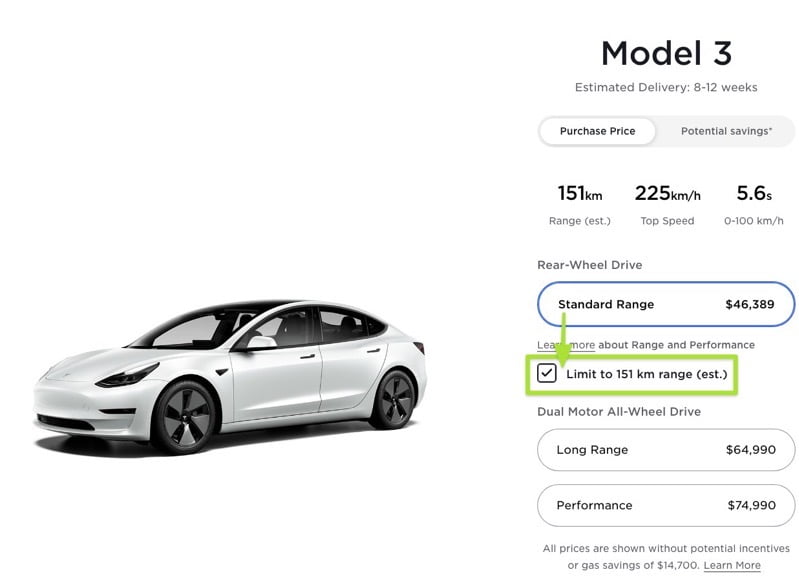
Tesla ‘Gamed the System’ with Range-Limited Model 3 in Canada: Consumer Group

Image: Tesla
Canada launched its Incentives for Zero-Emission Vehicles (iZEV) program in May 2019 to subsidize the out-of-pocket cost of plug-in hybrid and battery-electric vehicles for Canadians, hoping that a price cut of up to $5,000 CAD would persuade buyers to go electric.
However, electric vehicles had to jump through a number of hoops to qualify. One requirement was the base trim of a car must be priced under $45,000 CAD, with other trims not exceeding $55,000 CAD for the car to qualify.
This originally rendered Tesla’s Model 3 Standard Range Plus (SR+) with a 263-mile (423 km) range ineligible for the $5,000 CAD rebate, as it was priced at $35,000 USD at the time, or about $46,670 CAD at the time.
In a blatantly obvious attempt to skirt that hurdle, Tesla started selling a Model 3 Standard Range (SR) with just 94 miles (151 km) of range and no Autopilot exclusively in Canada for $46,389 CAD.
Removing the $1,280 destination fee, the $100 air conditioning fee, and a $10 fee paid to the Ontario Motor Vehicle Industry Council, the base price of the Model 3 SR comes out to $44,999 CAD — just one dollar below the $45,000 CAD eligibility cut-off for iZEV rebates.
With its abysmal range, the Model 3 SR serves no purpose other than to qualify the superior, 293-mile Model 3 SR+ that is a much better value at a base price of $52,990 CAD for the federal iZEV program.
In a recent report, The Drive analyzes the impact of the Model 3 SR+’s qualification for the iZEV program due to the launch of the 94-mile variant.
According to the publication, Tesla only sold a measly 151 units of the 94-mile (151 km) Model 3 SR between the launch of the iZEV program and April, 2021, based on new data from Transport Canada. The Standard Range Model 3 only accounted for $755,000 CAD in rebates from the iZEV program.
On the other hand, Tesla sold a whopping 22,938 units of the Model 3 Standard Range Plus during the same time. The Model 3 SR+, which only qualified for the iZEV program because of its lesser sibling, took home $114,690,000 CAD out of the rebate fund.
Tesla making a 94-mile variant available in Canada resulted in the Model 3 raking in $115.5 million CAD in federal rebates — 26% of the entire iZEV fund, which has supplemented the sale of over 74,000 eligible vehicles as of January, 2021.
“It certainly looks like Tesla gamed the system by listing a no-frills model just under the maximum price in order to get access to millions in taxpayer subsidies for higher-priced models,” said Aaron Wudrick, federal director of the Canadian Taxpayers Federation.
Given Tesla’s dedication to selling vehicles that offer as much range as practically possible, launching a car with a range that’s un-apologetically bad for a Tesla was seen by some as a clear farce, and by others as brilliant.
Canada’s department of motor vehicles, Transport Canada, says that the goal of the iZEV program is simply to increase the affordability of sustainable transportation and encourage plug-in hybrid and electric vehicle adoption. Tesla’s methods, as polarizing as they may be, did do exactly that.

